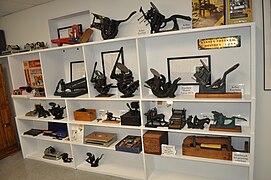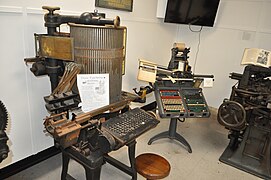
A mimeograph machine was a low-cost duplicating machine that worked by forcing ink through a stencil onto paper. The process was called mimeography, and a copy made by the process was a mimeograph.
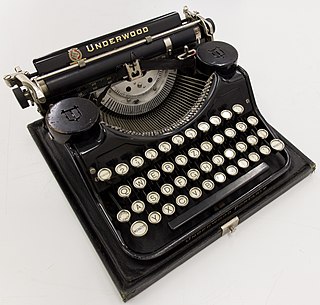
A typewriter is a mechanical or electromechanical machine for typing characters. Typically, a typewriter has an array of keys, and each one causes a different single character to be produced on paper by striking an inked ribbon selectively against the paper with a type element. Thereby, the machine produces a legible written document composed of ink and paper. By the end of the 19th century, a person who used such a device was also referred to as a typewriter.
Desktop publishing (DTP) is the creation of documents using dedicated software on a personal ("desktop") computer. It was first used almost exclusively for print publications, but now it also assists in the creation of various forms of online content. Desktop publishing software can generate page layouts and produce text and image content comparable to the simpler forms of traditional typography and printing. This technology allows individuals, businesses, and other organizations to self-publish a wide variety of content, from menus to magazines to books, without the expense of commercial printing.
The Mergenthaler Linotype Company is a corporation founded in the United States in 1886 to market the Linotype machine, a system to cast metal type in lines (linecaster) invented by Ottmar Mergenthaler. It became the world's leading manufacturer of book and newspaper typesetting equipment; outside North America, its only serious challenger for book typesetting was the Anglo-American Monotype Corporation.
In writing, a space is a blank area that separates words, sentences, syllables and other written or printed glyphs (characters). Conventions for spacing vary among languages, and in some languages the spacing rules are complex. Inter-word spaces ease the reader's task of identifying words, and avoid outright ambiguities such as "now here" vs. "nowhere". They also provide convenient guides for where a human or program may start new lines.

Typesetting is the composition of text for publication, display, or distribution by means of arranging physical type in mechanical systems or glyphs in digital systems representing characters. Stored types are retrieved and ordered according to a language's orthography for visual display. Typesetting requires one or more fonts. One significant effect of typesetting was that authorship of works could be spotted more easily, making it difficult for copiers who have not gained permission.

Matthew Carter is a British type designer. A 2005 New Yorker profile described him as 'the most widely read man in the world' by considering the amount of text set in his commonly used typefaces.

Letterpress printing is a technique of relief printing for producing many copies by repeated direct impression of an inked, raised surface against individual sheets of paper or a continuous roll of paper. A worker composes and locks movable type into the "bed" or "chase" of a press, inks it, and presses paper against it to transfer the ink from the type, which creates an impression on the paper.

Phototypesetting is a method of setting type which uses photography to make columns of type on a scroll of photographic paper. It has been made obsolete by the popularity of the personal computer and desktop publishing which gave rise to digital typesetting.

Monotype Imaging Holdings Inc., founded as Lanston Monotype Machine Company in 1887 in Philadelphia by Tolbert Lanston, is an American company that specializes in digital typesetting and typeface design for use with consumer electronics devices. Based in Woburn, Massachusetts, the company has been responsible for many developments in printing technology—in particular the Monotype machine, which was a fully mechanical hot metal typesetter, that produced texts automatically, all single type. Monotype was involved in the design and production of many typefaces in the 20th century. Monotype developed many of the most widely used typeface designs, including Times New Roman, Gill Sans, Arial, Bembo and Albertus.

In printing and typography, hot metal typesetting is a technology for typesetting text in letterpress printing. This method injects molten type metal into a mold that has the shape of one or more glyphs. The resulting sorts or slugs are later used to press ink onto paper. Normally the typecasting machine would be controlled by a keyboard or by a paper tape.

The Lowell Line is a railroad line of the MBTA Commuter Rail system, running north from Boston to Lowell, Massachusetts. Originally built as the New Hampshire Main Line of the Boston & Lowell Railroad and later operated as part of the Boston & Maine Railroad's Southern Division, the line was one of the first railroads in North America and the first major one in Massachusetts.

Sabon is an old-style serif typeface designed by the German-born typographer and designer Jan Tschichold (1902–1974) in the period 1964–1967. It was released jointly by the Linotype, Monotype, and Stempel type foundries in 1967. The design of the roman is based on types by Claude Garamond, particularly a specimen printed by the Frankfurt printer Konrad Berner. Berner had married the widow of a fellow printer Jacques Sabon, the source of the face's name, who had bought some of Garamond's type after his death. The italics are based on types designed by a contemporary of Garamond's, Robert Granjon. It is effectively a Garamond revival, though a different name was chosen as many other modern typefaces already carry this name.
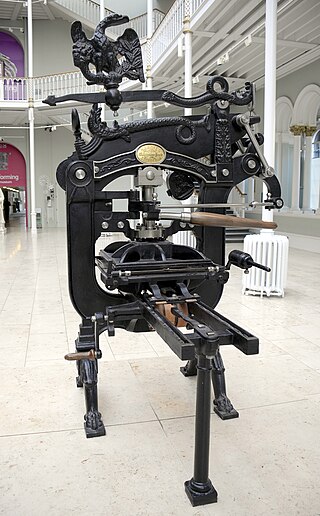
The Columbian press is a type of hand-operated printing press invented in the United States by George Clymer, around 1813. Made from cast iron, it was a very successful design and many thousands were made by him and by others during the 19th century. Columbians continued to be made as late as the early-20th century, 90 years after their introduction. Despite their age, many are still used for printing, especially by artists who make prints using traditional methods.
Compugraphic Corporation, commonly called cg, was an American producer of typesetting systems and phototypesetting equipment, based in Wilmington, Massachusetts, just a few miles from where it was founded. This company is distinct from Compugraphics, a British company founded 1967 in Aldershot, UK that specializes in the production of photomasks used in the production of integrated circuits. In 1981, it was acquired by European competitor Agfa-Gevaert, and its products and processes merged into those of Agfa. By 1988, the merger was complete and the Compugraphic brand was removed from the market.

The Grabhorn Institute is a nonprofit organization formed in October 2000 for the purpose of preserving and continuing the operation of one of the last integrated facilities for typefounding, letterpress printing, and bookbinding in the fine press tradition, as a living museum and educational and cultural center. It is named in honor of the brothers Edwin and Robert Grabhorn, who established the Grabhorn Press in San Francisco in 1920. The press was "one of the foremost producers of finely printed books in twentieth-century America." The Grabhorn Press Building is listed on the National Register of Historic Places in San Francisco, California.
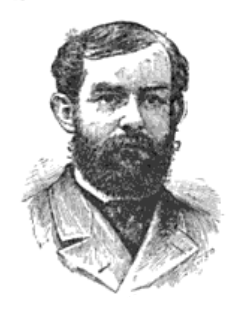
James Ogilvie Clephane was an American inventor, bar-admitted stenographer who served in Abraham Lincoln's cabinet, private secretary to Secretary of State William Seward, and venture capitalist in both Washington, D.C., and New York City. James O. Clephane led the funeral procession of his friend and employer, President Abraham Lincoln, down Pennsylvania Avenue as a civic marshal, and was followed by "three hundred marshals and assistant marshals, eleven Major-Generals, eighty-four Brigadier- Generals, twelve hundred other military officers, one hundred and fifty naval officers including Vice Admiral Farragut, and one hundred and eight Senators and mem- bers of Congress. In the procession were eighteen thousand. The witnesses were estimated at one hundred and fifty thousand."
Walter Valentine Tracy RDI was an English type designer, typographer and writer.

The Ben Lane Print Shop is a demonstration site at Shelburne Museum in Shelburne, Vermont, in the United States.

The history of sentence spacing is the evolution of sentence spacing conventions from the introduction of movable type in Europe by Johannes Gutenberg to the present day.







